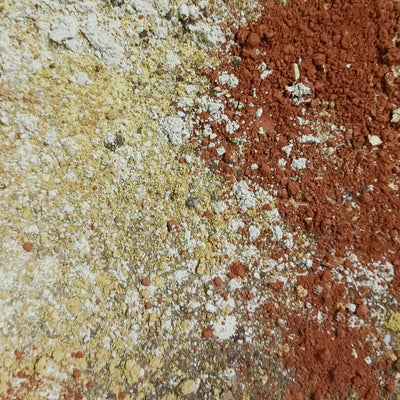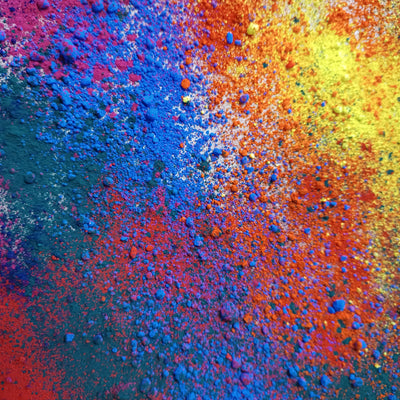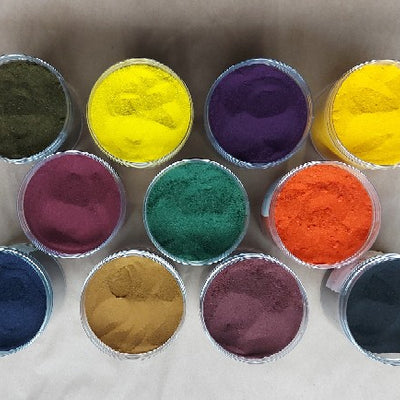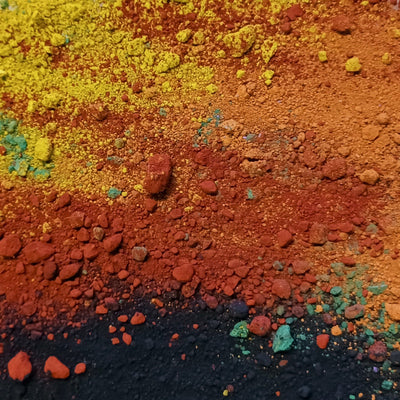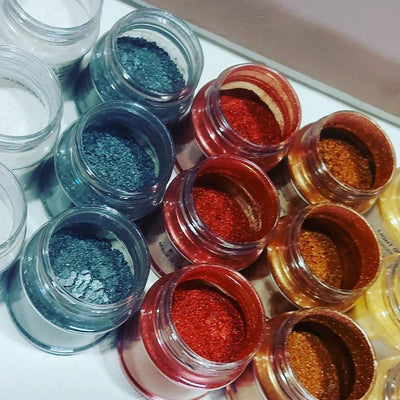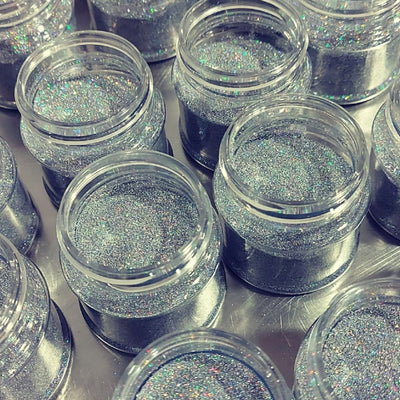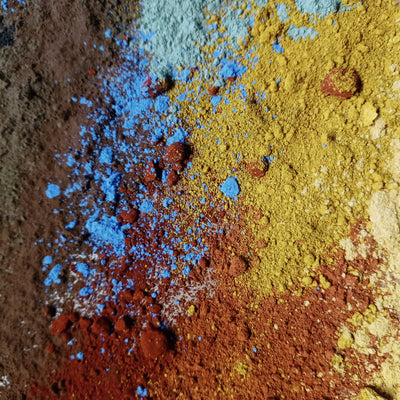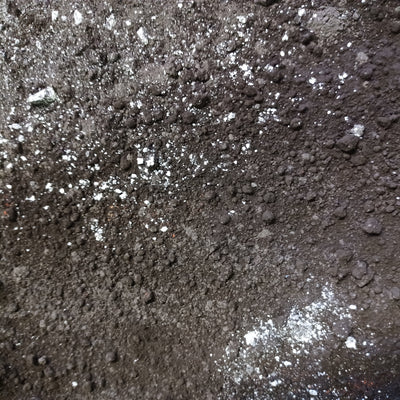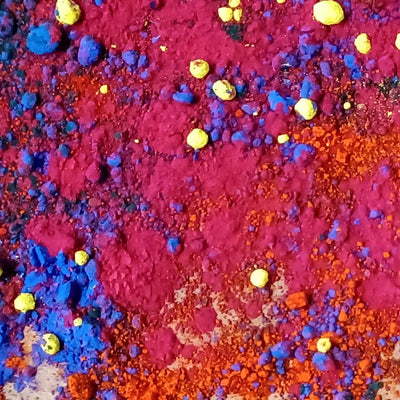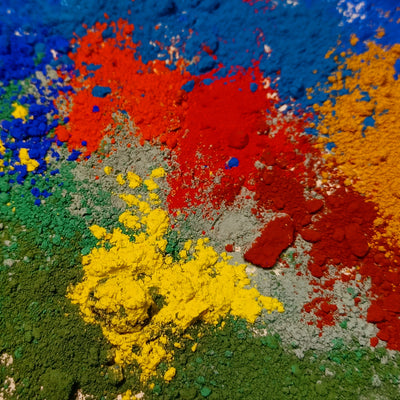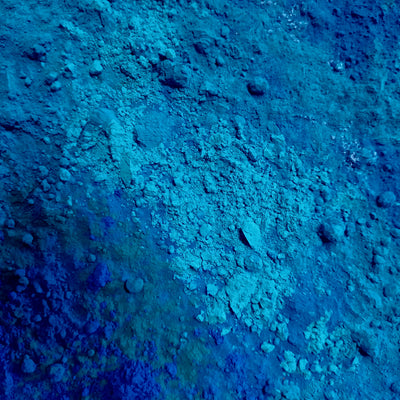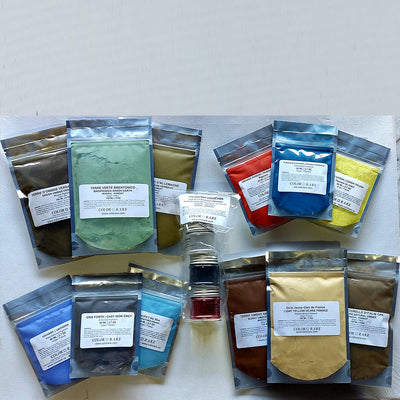Pigments can be utilized for a multitude of coloring uses; for concrete, cement, mortar, plaster, lime, clay, and other masonry products, as well as milk, flour, lime, clay, and other natural-based paints and decorative wall coatings. Pigments may also be used for artistic and decorative painting. An endless array of colors can be achieved for all types of applications.
Follow the Coloration Guide to properly mix your pigment. It’s EASY! Combine 1 part pigment to 1 part water (ex: using 20ml of pigment would require 20ml of water), mix well, and stir into your masonry product or paints mixture. Or add pigments directly to other oil-based binders, such as glycerin, resins, waxes, and varnishes. A maximum of 10% volume of the pigment should be added to your mixture. To ensure consistent coloring, keep all variables the same from batch to batch. Variations in the mix design and curing conditions may affect the final color.
Terrachrom offers the whole spectrum: from natural earth & mineral pigments for soft natural tones, to the SP series for bright and trendy colors.
Are you looking for a particular pigment? Do you require larger quantities (25KG)? Do not hesitate to contact us; we offer over 900 different pigments….
WARNING KEEP OUT OF REACH OF CHILDREN. Do not swallow or inhale. The use of safety glasses and facemask is recommended due to the risk of projection while handling. In case of eye contact, flush immediately with water. If you have sensitive skin, it is recommended to use gloves while handling. Use with adequate ventilation.
Natural Pigments
Mineral Pigments: Pigments obtained from natural earth, ochres, and oxides (clay containing ferric oxide), extracted from quarries. Good UV resistance, non-toxic. Yields soft natural tones. Matte and opaque finish.
Effervescent Earths Pigments: Mineral pigments combined with tartaric acid and calcium carbonate to create an effervescent effect when mixed in water. This effervescence optimizes the coloring properties of the pigment and facilitates its dispersion. Extremely good UV resistance. Yields soft natural tones. Matte and opaque finish.
Manufactured Pigments
Enhanced Pigments: Mineral-based pigments, synthetically recolored. Yields bright & trendy colors.
SP Super Pigments: Blend of pigments (organics or inorganic /minerals) that are easily dispersing and highly concentrated. Good UV resistance. Very little pigment yields bright & trendy colors. Ideal for concrete and lime products. (The color of the pigments prior to being dispersed in water is not representative of their true color.)
Inorganic Synthetic Pigments: Ferric oxides derived from chemistry processes (ex Titanium Dioxide)
Using Pigments to Tint Concrete
NOTE: Always do a small test batch before tinting a full batch. This will confirm the pigment color, pigment quantity needed, and that the method used achieves your desired effect. Once you’ve established your formula, use the same products, quantities, and method for the same project. This will reduce the risk of inconsistency. Variations in the mix design and curing conditions may affect the final color.
First, some background! All concrete products contain cement, otherwise known as cementitious materials. The cement acts as a binder between pigment, sand, aggregates, and the added water, gluing everything together. It’s the cement, and the paste that’s created when water is added, that incorporates and binds the pigment particles in the product and prevents them from being washed away.
The color of the cement affects the final color of the product. Gray cement works best with darker colors while white cement (and white aggregates) produces brighter shades. You can hand mix your own concrete using raw materials, or you can purchase premixed concrete products. For large projects and consistency of color and shade across large surfaces, it’s highly recommended that you use raw materials. Premixed concrete products are best for small projects. Also, for long-term, better strength results, the concrete should be kept wet for several days to complete the hydration process.
The amount of pigment required depends on the pigment tinting strength, the desired color, and shade (pale or dark), as well as the method used. The amount of pigment added to a concrete mix is determined by weight as a percentage of the weight of the cementitious materials. We recommend using a maximum of 10% pigment. Using more than 10% pigment will affect the strength of the concrete. Usually, 5-6% of pigment is enough to achieve desired color saturation.
Our SP Super Pigments line of products works well for bright colors, as they are up to 10x more concentrated than regular ochres and oxides. Ochres and Oxides will yield paler tones and require more pigment. You’ll find more information on the Super Pigments here: https://colorare.com/collections/sp.
Typical ratios when coloring concrete in large batches are:
- 10kg of oxide pigment/m³ (10oz/ft³), and
- 12-20kg of earths-ochres/m³ (12-20 oz/ft³)
General instructions for tinting concrete products are:
- For hand-mixed concrete using raw materials:
- first, add the powder pigment directly to the sand and aggregates, and mix well
- then add this to the cement along with water, and mix well
- For premixed concrete (comes in dry form):
- first, mix 1 part pigment with 1 part water
- then add this to the premixed concrete and follow the package mixing instructions
Other tinting methods include sprinkling pigments on a wet concrete surface, which can then be burnished with a finishing trowel (or brushed) to create unique effects. Or, adding pigments to a concrete sealer or protective coat. These methods require less pigment than coloring the concrete. Depending on the color you are looking to create, we suggest adding:
- 50 - 100 ml of pigment powder per litre of sealant (approx. 4L per gallon).
For more information or if you have any questions, please contact us.

